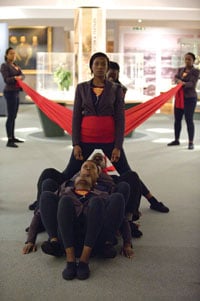It’s not black or white
Following a recent panel discussion on the future of black British theatre, Pat Cumper takes stock of the sector

There is a great deal to be celebrated in black British theatre. Our actors are performing their socks off and enjoy considerable respect in the wider theatre community: Kobna Holdbrook-Smith, Jenny Jules, Nikki Amuka-Bird, David Harewood … the list goes on. Playwrights are also broadening their remit to explore more universal themes, the range of which, in my view, has expanded – black British writers are telling stories that move beyond victimhood, often across class and race in challenging and subtle ways. With rave reviews for Michael Buffong’s ‘Raisin In The Sun’ at the West Yorkshire Playhouse earlier this year and the exciting work by new directors such as Gbolahan Obesisan and Rae McKen, our directors are making their mark too. All in all, it’s a positive time.
VERCOMING OBSTACLES
The obstacles slowing good work down? For actors such as those above, there could be more work. For writers, it’s getting a foot in the door and getting that work staged. Venues, to me, presently seem more interested in plays from Africa and America than in homegrown work – unless it is about the disadvantaged. And for directors? Not enough of them are being trusted with the larger stages; too few are working enough to make a decent living. Producers? That’s a knottier question. Artistic directors and venue programmers? Now there’s an almighty problem. They are few and far between, and often, in my opinion, weighed down by the burden of representation.
The biggest hurdle? The debate around the quality of black, Asian or other work. I can’t tell you how often over the past five years I have heard ‘quality’ being cited, directly or indirectly, as the reason why there isn’t more of this work playing the main stages. But the underlying question must always be: who has the right to decide what is and isn’t good work? Funders, critics or audiences? Are Black, Asian and minority ethnic (BAME) artists right to feel that white audiences are more comfortable with tales of violence and victimhood in black stories, of Bollywood, arranged marriages and terrorism in Asian stories, rather than the work that practitioners want to create and diverse audiences want to see?
WHY DEVELOP NEW AUDIENCES?
In London, the last census recorded 29% of the population as non-white and the Olympic bid was built around London’s reputation as a vibrant, multicultural city. But, sadly, this isn’t reflected in the current power structure of British arts. There are good reasons for this. Theatre, wonderful art form that it is, is (in the funded mainstream at least) often paralysed by being text-based and middle class. It engages with society and its audiences largely from that single point of view. Many of the larger, more prestigious buildings make it clear whom they welcome: overpriced wine and organic nibbles anyone? The programming affirms that contract and their audiences keep coming. Why shouldn’t they? The buildings do what they do very well. And if their productions are selling out, why should they have to change? After all, it has been made very clear by countless marketing initiatives and many black and Asian inclusions in the programming of such buildings, it isn’t easy getting new audiences in.
THE SECTOR’S RESPONSE
In case this looks like finger pointing, I want to talk about how BAME artists are responding. Over the past four years, a long but often robust consultation has taken place in response to the report on BAME theatre by Baroness Lola Young. The upshot is that there are eight regional hubs of diverse artists, working together under the umbrella of a process called ‘Sustained Theatre’, creating partnerships, critiquing and supporting each other’s work and lobbying for what they feel they need to develop their work and their audiences. The buildings and those who make work within them have to begin a different conversation with audiences if they want to deliver Arts Council England’s laudable ambition of great art for everyone. In order to have that conversation, the audiences first have to want to come to the theatre. For my money, some of those renewed conversations have therefore to start with an engagement with BAME practitioners as equals with particular and valuable skills and resources.
The histories of Europe, Asia and Africa have intertwined for millennia. The energy released when these cultures meet is extraordinary and part of what makes London such a vibrant world leader. To my mind, the future of black British theatre is not a plea for a place on the British stage but an invitation to be part of an eclectic and vibrant cultural movement.
Join the Discussion
You must be logged in to post a comment.